Recombinant Mouse ADP/ATP translocase 1 (Slc25a4)
-
货号:CSB-CF021510MO
-
规格:
-
来源:in vitro E.coli expression system
-
其他:
产品详情
-
基因名:
-
Uniprot No.:
-
别名:Slc25a4; Aac1; Anc1; Ant1; ADP/ATP translocase 1; ADP,ATP carrier protein 1; ADP,ATP carrier protein, heart/skeletal muscle isoform T1; Adenine nucleotide translocator 1; ANT 1; Solute carrier family 25 member 4
-
种属:Mus musculus (Mouse)
-
蛋白长度:Full Length of Mature Protein
-
表达区域:2-298
-
氨基酸序列GDQALSFLKDFLAGGIAAAVSKTAVAPIERVKLLLQVQHASKQISAEKQYKGIIDCVVRI PKEQGFLSFWRGNLANVIRYFPTQALNFAFKDKYKQIFLGGVDRHKQFWRYFAGNLASGG AAGATSLCFVYPLDFARTRLAADVGKGSSQREFNGLGDCLTKIFKSDGLKGLYQGFSVSV QGIIIYRAAYFGVYDTAKGMLPDPKNVHIIVSWMIAQSVTAVAGLVSYPFDTVRRRMMMQ SGRKGADIMYTGTLDCWRKIAKDEGANAFFKGAWSNVLRGMGGAFVLVLYDEIKKYV
Note: The complete sequence including tag sequence, target protein sequence and linker sequence could be provided upon request. -
蛋白标签:N-terminal 10xHis-tagged
-
产品提供形式:Liquid or Lyophilized powder
Note: We will preferentially ship the format that we have in stock, however, if you have any special requirement for the format, please remark your requirement when placing the order, we will prepare according to your demand. -
缓冲液:Lyophilized from Tris/PBS-based buffer, 6% Trehalose, pH 8.0
-
储存条件:Store at -20°C/-80°C upon receipt, aliquoting is necessary for mutiple use. Avoid repeated freeze-thaw cycles.
-
保质期:The shelf life is related to many factors, storage state, buffer ingredients, storage temperature and the stability of the protein itself.
Generally, the shelf life of liquid form is 6 months at -20°C/-80°C. The shelf life of lyophilized form is 12 months at -20°C/-80°C. -
货期:Basically, we can dispatch the products out in 1-3 working days after receiving your orders. Delivery time may differ from different purchasing way or location, please kindly consult your local distributors for specific delivery time.Note: All of our proteins are default shipped with normal blue ice packs, if you request to ship with dry ice, please communicate with us in advance and extra fees will be charged.
-
注意事项:Repeated freezing and thawing is not recommended. Store working aliquots at 4°C for up to one week.
-
Datasheet & COA:Please contact us to get it.
相关产品
靶点详情
-
功能:ADP:ATP antiporter that mediates import of ADP into the mitochondrial matrix for ATP synthesis, and export of ATP out to fuel the cell. Cycles between the cytoplasmic-open state (c-state) and the matrix-open state (m-state): operates by the alternating access mechanism with a single substrate-binding site intermittently exposed to either the cytosolic (c-state) or matrix (m-state) side of the inner mitochondrial membrane. In addition to its ADP:ATP antiporter activity, also involved in mitochondrial uncoupling and mitochondrial permeability transition pore (mPTP) activity. Plays a role in mitochondrial uncoupling by acting as a proton transporter: proton transport uncouples the proton flows via the electron transport chain and ATP synthase to reduce the efficiency of ATP production and cause mitochondrial thermogenesis. Proton transporter activity is inhibited by ADP:ATP antiporter activity, suggesting that SLC25A4/ANT1 acts as a master regulator of mitochondrial energy output by maintaining a delicate balance between ATP production (ADP:ATP antiporter activity) and thermogenesis (proton transporter activity). Proton transporter activity requires free fatty acids as cofactor, but does not transport it. Probably mediates mitochondrial uncoupling in tissues that do not express UCP1. Also plays a key role in mPTP opening, a non-specific pore that enables free passage of the mitochondrial membranes to solutes of up to 1.5 kDa, and which contributes to cell death. It is however unclear if SLC25A4/ANT1 constitutes a pore-forming component of mPTP or regulates it. Acts as a regulator of mitophagy independently of ADP:ATP antiporter activity: promotes mitophagy via interaction with TIMM44, leading to inhibit the presequence translocase TIMM23, thereby promoting stabilization of PINK1.
-
基因功能参考文献:
- The ANT1-deficient muscle mitochondria produce excess reactive oxygen species (ROS) and are partially uncoupled. Hence, the muscle respiration under nonphosphorylating conditions is increased. Muscle transcriptome analysis revealed the induction of mitochondrial biogenesis, down-regulation of diabetes-related genes, and increased expression of the genes encoding the myokines FGF21 and GDF15. PMID: 28223503
- ANT1 can induce autoimmune myocarditis in A/J mice by generating autoreactive T cells. PMID: 27876151
- miR-2861 and ANT1 are regulators of cardiomyocyte necrosis and myocardial infarction. PMID: 26654759
- These results suggest that follicular helper T cells cells and IL-21 might be involved in the pathogenesis of viral myocarditis and play an important role in anti-ANT autoantibody production. PMID: 25889760
- Data indicate that palmitoyl-carnitine (PC) increases the type 2 ryanodine receptor (RyR2) oxidation and reduces the ATP/ADP translocase (ANT) activity. PMID: 25619687
- Downregulation of adenine nucleotide translocator 1 exacerbates tumor necrosis factor-alpha-mediated cardiac inflammatory responses. PMID: 25380814
- Its mutation causes some inherited Parkinson disease. PMID: 24325796
- Plasma membrane-localized ANT1 and ANT2 regulate L1-mediated neurite outgrowth in conjunction with MMP14. PMID: 22423112
- Although the molecular mechanism linking ANT1-Cys(57) nitroalkylation and uncoupling is not yet known, these data suggest that ANT1-mediated uncoupling may be a mechanism for nitroalkene-induced cardioprotection. PMID: 22158628
- The attenuation of ANT-1 in the presence of PGC-1alpha overexpression preserves the mitochondrial membrane potential in response to hydrogen-peroxide stress. PMID: 20600099
- Data demonstrate that ANT1 protein levels are upregulated in Mecp2-null mice. PMID: 20504995
- uncoupling protein-3 can minimize the induction of the adenine nucleotide translocase-mediated 'energy-wasting' process during Calorie restriction (CR). PMID: 20206124
- The astrocytic response to CNS injury includes an apparent increase in energy mobilization capacity by Ant1 that contributes to neuroprotective, energy-dependent glutamate uptake PMID: 12781988
- ANTs are non-essential structural components of the mitochondrial permeability transition pore, although they do contribute to its regulation PMID: 14749836
- half to two-thirds of the basal proton conductance of mitochondria is catalysed by the adenine nucleotide carrier, independently of its ATP/ADP exchange or fatty-acid-dependent proton-leak functions PMID: 16076285
- The ANT1 isoform may mediate a significant part of the high basal proton leak in brown-fat mitochondria. PMID: 16831128
- The Ant1 deficient mouse skeletal muscle demonstrates that energy metabolism, antioxidant defenses, and apoptosis form an integrated metabolic network. PMID: 18439414
- Cardiomyocyte-restricted overexpression of ANT1 prevents the development of diabetic cardiomyopathy; therefore, accelerated ADP/ATP exchange could be a new promising target to treat diabetic cardiomyopathy. PMID: 18945756
- Inhibition by cyclosporin A prevents pyrazole plus lipopolysaccharide-induced liver injury PMID: 19026739
- The mitochondrial membrane potential of Ant1-deficient brain mitochondria is increased and the permeability transition pore is more resistant to calcium induced permeability transition. PMID: 19366611
- Data indicate that ANT mediates cell death, not through the MPT pore, but rather via a ROS-dependent upregulation and activation of Bax. PMID: 19452617
显示更多
收起更多
-
亚细胞定位:Mitochondrion inner membrane; Multi-pass membrane protein. Membrane; Multi-pass membrane protein.
-
蛋白家族:Mitochondrial carrier (TC 2.A.29) family
-
组织特异性:Highly expressed in heart, skeletal muscle and brain.
-
数据库链接:
KEGG: mmu:11739
STRING: 10090.ENSMUSP00000034049
UniGene: Mm.16228
Most popular with customers
-
Recombinant Human Semaphorin-4D (SEMA4D), partial (Active)
Express system: Mammalian cell
Species: Homo sapiens (Human)
-
Recombinant Human Plexin-B1 (PLXNB1), partial (Active)
Express system: Mammalian cell
Species: Homo sapiens (Human)
-
Recombinant Macaca fascicularis Claudin (CLDN18)-VLPs (Active)
Express system: Mammalian cell
Species: Macaca fascicularis (Crab-eating macaque) (Cynomolgus monkey)
-
Recombinant Macaca fascicularis CD44 antigen (CD44), partial (Active)
Express system: Mammalian cell
Species: Macaca fascicularis (Crab-eating macaque) (Cynomolgus monkey)
-
Express system: Mammalian cell
Species: Homo sapiens (Human)
-
Recombinant Macaca fascicularis Membrane spanning 4-domains A1 (MS4A1)-VLPs (Active)
Express system: Mammalian cell
Species: Macaca fascicularis (Crab-eating macaque) (Cynomolgus monkey)
-
Recombinant Human Myosin regulatory light polypeptide 9 (MYL9) (Active)
Express system: Yeast
Species: Homo sapiens (Human)
-
Recombinant Human Killer cell immunoglobulin-like receptor 3DL2 (KIR3DL2), partial (Active)
Express system: Mammalian cell
Species: Homo sapiens (Human)




















